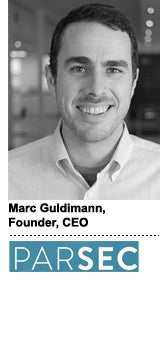 Parsec, an ad network that creates what it calls “politely interruptive” ad experiences, raised $1.5 million in seed funding on Wednesday from a slew of big-name backers in the ad space.
Parsec, an ad network that creates what it calls “politely interruptive” ad experiences, raised $1.5 million in seed funding on Wednesday from a slew of big-name backers in the ad space.
Some of those investors include Jonah Goodhart, the CEO of Moat, who made his contribution by way of early stage capital investor group WGI; Brett Wilson, the CEO of video ad platform TubeMogul and Brendan Spain, VP of advertising for the Americas at the Financial Times.
Parsec plans to put its fresh injection toward new headcount and to expand its product to other formats like branded content and mobile video.
The company, which employs 19, has consistently hired about two people per month since the beginning of the year, and was already profitable pre-raise, according to its founder and CEO Marc Guldimann.
“We realized early on that people paid for impressions that had zero correlation to how much value advertisers extracted from the media,” Guldimann said, reflecting on his days as co-founder of early dynamic creative tool Spongecell. “We tried to reflect the actual amount of attention being transferred from the publisher to the advertiser.”
Parsec works with publishers including Time Inc., Hearst, IAC and AOL, in addition to brand clients like Dell, Colgate and BMW. All media is sourced directly on an IO basis and Parsec prices on a so-called “cost-per-second” basis depending on time spent versus a standard CPM.
Although the move toward attention metrics has been slow, certain publishers like the Financial Times have already tested the waters.
The Financial Times first deployed cost-per-hour (CPH) ads on-site using Chartbeat in 2015, in which the publisher only charged advertisers if a unit was in view for at least five seconds.
FT views CPH as a more effective pricing model for certain advertisers because its audience is engaged and tends to enjoy longer-form content.
Others in the industry, like IPG Mediabrands and Integral Ad Science, also drafted early research demonstrating that the duration or time spent viewing an ad unit has a greater bearing on overall effectiveness and recall than only measuring the percentage of pixels in-view.
“The longer your ads are viewed on a page, the higher the likelihood of recall,” Guldimann said. “The [industry is] getting [better] at refining metrics to better reflect attention.”
In addition to its ad network, Parsec purveys a proprietary mobile web format called Sled, which comes in several flavors, including an interstitial that “slides” over article text when a user thumbs over content, as well as an interactive Sled Brand Lift survey tool.
The company has plans to roll out a similar offering for branded content and charge based on the amount of time someone spends actually reading the content.
Ultimately, executing a time-based buy in an auction environment may prove more difficult than facilitating a direct deal, but Guldimann sees an opportunity to steer the dialogue back to the quality of creative in media execution.
“When the duration equals the amount of time spent with the ad and you have a quality score component … it’s much higher value,” he said. “If you can A/B test with different creatives, you’re then able to have a meaningful conversation about what creative is good or bad based on how long someone spent time with it.”














